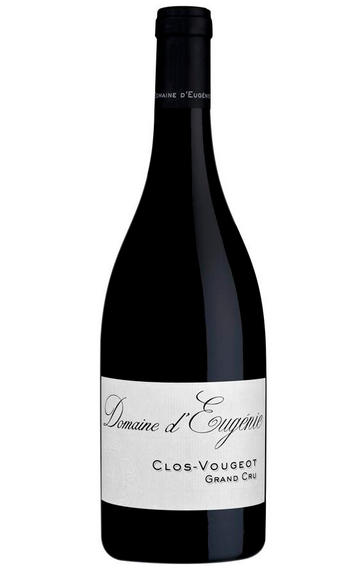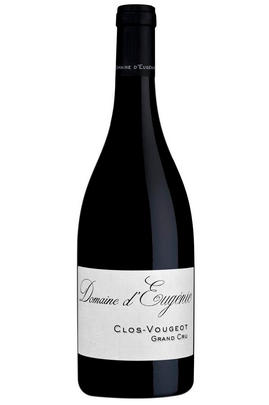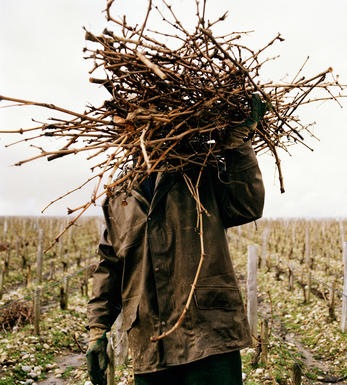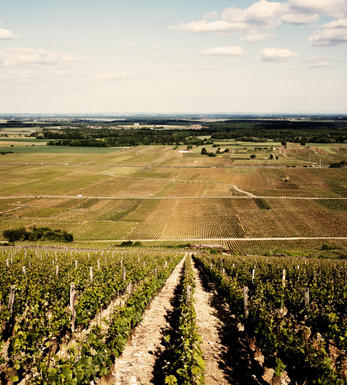
2018 Clos-Vougeot, Grand Cru, Domaine d'Eugénie, Burgundy

Critics reviews
Drink 2032+
Burghound (Jan 2020)
Drink 2024-2050
Neal Martin MW, Vinous (Nov 2018)
Drink 2025-2050
Jane Anson, Decanter (Jan 2020)
Drink 2025-2045
Jancis Robinson MW, jancisrobinson.com (Feb 2020)
Drink 2022-2040
Decanter (Feb 2020)
About this WINE

Domaine d'Eugenie
Domaine d'Eugénie is the reincarnation of the famed Domaine Engel. After the tragic early death of Philippe Engel in May 2005, his family decided to sell the domaine. The highest bidder was François Pinault, owner of Château Latour in Bordeaux, whose right-hand man Frédéric Engerer had long had a passion for burgundy. The 2005 harvest had already been sold off in bulk, but the new team, including young vigneron Michel Mallard from Ladoix, made the 2006, 2007 and 2008 in the Lupé Cholet headquarters in Nuits-St-Georges. From 2009 they have moved into the now refurbished Clos Frantin buildings in Vosne itself.
Yields are significantly lower than in Philippe’s day and the vineyards have been meticulously looked after, including a substantial programme of replacing missing individual vines, which will be picked separately and declassified into the village Vosne in their youth.
The principal decision is whether or not to keep any stems. None were retained in 2006, but an experiment with one of the two fermentation tanks of Clos de Vougeot the following year was positive, the blend of half with and half without stems showing textural qualities and a sense of energy over and above either individual version. The experiment has been continued in 2008 and extended to the Grands Echezeaux.
Otherwise, the grapes are vinified in fairly classical manner, with a preference for punching down rather than pumping over, then matured in barrel for a minimum of 15 months (village Vosne), or rather longer for the grands crus which receive around 80% of new wood.
The first vintage released by the Domaine was in 2006. The highly impressive 2007 vintage is a truly representative vintage for Domaine Eugenie, showing each of the vineyards in its true guise.
Jasper Morris MW, Burgundy Wine Director and author of the award-winning Inside Burgundy comprehensive handbook.

Vougeot
Most of the wine produced in this small village comes from a single, walled Grand Cru vineyard, the famous Clos de Vougeot. The vineyard in its present form dates from 1336 (when it was first planted by monks of Cîteaux), although it was not until the following century that it was entirely enclosed by stone walls.
Clos de Vougeot is both the smallest commune and the largest Clos in the Cote d’Or. It consists of 50 hectares of vineyards shared among 82 owners, with six soil types. There is quite a difference in quality between the upper (best) and lower (least fine) parts of the vineyard, though in medieval times a blend from all sectors was considered optimum.Le Domaine de la Vougeraie makes a very fine white wine from Le Clos Blanc de Vougeot, first picked out by the monks of Cîteaux as being suitable ground for white grapes in the year 1110.
- Five hectares of village Vougeot
- 12 hectares of Premier Cru vineyards (four in all): Les Cras, Les Petits-Vougeots, Clos de la Perrière and Clos Blanc de Vougeot
- 51 hectares of Grand Cru vineyard – Clos de Vougeot
- Recommended producers: Domaine de la Vougeraie, Domaine Bertagna, Engel, Anne Gros, Grivot, Liger-Belair, Meo-Camuzet.

Pinot Noir
Pinot Noir is probably the most frustrating, and at times infuriating, wine grape in the world. However when it is successful, it can produce some of the most sublime wines known to man. This thin-skinned grape which grows in small, tight bunches performs well on well-drained, deepish limestone based subsoils as are found on Burgundy's Côte d'Or.
Pinot Noir is more susceptible than other varieties to over cropping - concentration and varietal character disappear rapidly if yields are excessive and yields as little as 25hl/ha are the norm for some climats of the Côte d`Or.
Because of the thinness of the skins, Pinot Noir wines are lighter in colour, body and tannins. However the best wines have grip, complexity and an intensity of fruit seldom found in wine from other grapes. Young Pinot Noir can smell almost sweet, redolent with freshly crushed raspberries, cherries and redcurrants. When mature, the best wines develop a sensuous, silky mouth feel with the fruit flavours deepening and gamey "sous-bois" nuances emerging.
The best examples are still found in Burgundy, although Pinot Noir`s key role in Champagne should not be forgotten. It is grown throughout the world with notable success in the Carneros and Russian River Valley districts of California, and the Martinborough and Central Otago regions of New Zealand.


Buying options
Add to wishlist
Description
A much more floral-inflected nose is equally fresh and ripe with a broader range of spice elements adding breadth to the pretty red and blue pinot fruit aromas that are trimmed in noticeable if not invasive wood. The caressing and wonderfully vibrant medium-bodied flavors possess better mid-palate density before concluding in a lingering, balanced and much more complex finale. I like the focused drive of the finish; indeed this could aptly be described as a wine that delivers power without weight. I would further note that the 2017 is a relatively elegant example and, like the La Forge, a wine that could be approached on the earlier side, which is to say after 7 to 8 years.
Drink 2032+
Burghound (Jan 2020)
wine at a glance
Delivery and quality guarantee